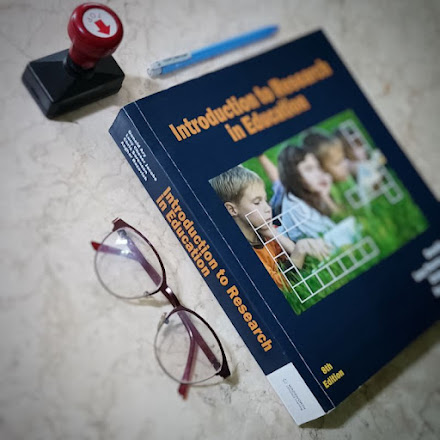Introducing Research Approaches in Education (A Resume of Introduction to Research in Education, Donald Ary et al p. 22-25, 8th Ed)
It is mentioned by Ary et al (2010) that the main
difference possessed by both quantitative and qualitative research are based on the
philosophical assumption. The root of quantitative thought is based on the
positivism which existed around 19th century. Positivists believe
that everything should be tested both empirically and logically by following
some research procedures (Amir Syarifuddin, 2015). They also believe that the
general principles of social science is just the same with the principles of
physical world (Ary et al, 2010). Thus, by some objective procedures, the
researchers are able to discover these principles which are useful to
understand human behavior. The traditional scientific method which is used by
positivists to find dependable knowledge involves hypothesis testing and
objective data gathering to meet systematic, generalizable, and open to
replicate by other investigators. Hence,
this kind of research is also called by the deductive one because we can create
a hypothesis in the beginning.
The qualitative method is applied by the different
philosophical approach. It starts by the belief that a person is interconnected
with others, which means a man would have no existence without others. In quantitative research, the
researchers try to find what people do. Meanwhile qualitative research
highlights the way how people think and feel. Ary et al (2010) povits that we
cannot deny people’s reality. That is why, the result of qualitative study is a
comprehensive and rich narrative report. Besides, because of the researcher
cannot interpret how naturally some events occur, then they cannot make any
hypothesis in the beginning. Next, we call this qualitative research as an
inductive one.
Aside from those two big approaches of research, Ary et al (2010) also provides another approach which involves the combination of both qualitative and quantitative research, namely mixed method. Historically, this mixed method found when the qualitative and quantitative researchers based had some adversarial. However, after realizing that those two methods are complementary, finally they decided to use this mixed method to find more dependable knowledge. However, the more complete materials about mixed method approach is not explained more in this chapter. Ary et al (2010) elucidates more in the following chapter.
Next, at these earlier pages, Ary et al (2010) presents a table that distinguish quantitative and qualitative thought to ease the readers the differences of those two. The table is presented below:
|
|
Quantitative |
Qualitative |
|
Purpose |
To study relationship, case and effect |
To examine a phenomenon as it is, in
rich detail |
|
Design |
Developed prior to study |
Flexible, evolves during study |
|
Approach |
Deductive; test theory |
Inductive, may generate theory |
|
Tools |
Uses preselected instruments |
The researcher is primary data collection tool |
|
Sample |
Uses large samples |
Uses small samples |
|
Analysis |
Statistical Analysis of numeric data |
Narrative description and interpretation |
Table 1. Comparison of Quantitative and Qualitative Research,
Ary et al (2010), p. 25



Comments
Post a Comment